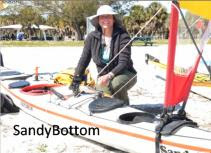 |
| 6:48 AM on Core Sound October 1, 2011 |
Dawn Patrol on Core Sound
At 6:30 AM the sky and waters were bathed in soft colors of an advancing sunrise. The Core Sound 20 Dawn Patrol was exactly where she was meant to be: on a stealthy mission in the middle of Core Sound reaching at 5-8 kts aided by a spinnaker. The time and place were perfect for relaxed cruising and camping aboard the Dawn Patrol. Instead, we were racing. We were trying to keep each other awake after 23 hours of non-stop sailing (12 hours in the dark). Staying warm was also a challenge even while wearing almost every stitch of high-tech warm-and-fuzzy clothing we had packed. It was a very cold and windy night. Now, like the cavalry arriving just in time, relief was coming over the horizon. We knew the sun would soon rise and warm us. Already we could see the channel markers. We began to think clearly enough to celebrate with hot chocolate and hot coffee. In less than an hour the sun would be up. In less than 4 hours we would cross the finish line and enjoy a hot shower and some sleep.
At about 6:30 the Bushnell trail camera silently switched automatically from stealthy IR-flash mode to full-color-daylight mode. It continued shooting every 15 seconds to capture hundreds of images from its position on the tiller aft of the transom.
Below are some of my favorite still images from that morning, as well as a time-lapse video (4.5 minutes) spanning the final four hours of our NCC adventure race. The Bushnell's clock was faulty but the time stamps shown on the images have been corrected.
 |
| Next channel marker in Core Sound |
Time-Lapse Video
From 6:45 - 10:15 AM the Bushnell "tiller cam" gave us hundreds of images. Minus a few images edited out, a sequence of 883 images is shown in the video at a rate of 1 frame per 0.3 seconds. Despite the camera's narrow 50-degree field of view, this video is an interesting part of our time-lapse experiment with this camera.
Welcome aboard to take a ride on the Dawn Patrol.....
Time-Lapse Video
6:45 to 10:15
6:45 to 10:15
 |
| GPS Track |
 |
| GPS Speeds |
We put away the spinnaker at 7:00 AM. At 7:15 our speed peaked at 8 kts and gradually declined to 5 kts by 8:00. At 8:15 we reefed both sails.
Are You Awake?
The 300mile Everglades Challenge often features long open-water transits appropriate for single-handed sailing. That makes it possible for a crew of two to take turns taking occasional 2-3 hour naps. Not so in the 100mile NCC! The frequently changing environments and weather of the NCC route kept both of us on non-stop active duty. As in the NCC 2010, staying awake became a challenge in the the pre-dawn hours. For example, SOS is at the tiller but his eyes have closed and his head is drooping.
DWSB: "Are you awake?"
SOS: "Yes!" he says, straightening his posture.
DWSB: "Your eyes were closed."
SOS: "Oh I know this route so well I don't need my eyes open to see it."
In the pre-dawn hours we attempted conversation to stay awake. However, we discovered it is possible to fall asleep while talking and it is even easier to fall asleep while listening. It is also easy to be asleep while you think you are talking. For example: SOS is speaking but I have stopped hearing him and I am dreaming something I believe he is saying. Now he is asking me something again. My reply is ridiculous and he laughts at my non sequitur. Unavoidably, we took turns at this "game". Towards 5:00 AM the game became more challenging and we craved sunrise.
The Sun Brings Wind and Waves
During the night, the cold front had rolled over us at about 10:00 PM. By the time we departed CP1 at nearly 1:00 AM, the NW wind was mostly steady at 6-15 kts and the waves were small. On our way out of Taylor Creek we had decided to continue on while the conditions were much better that we had expected. If conditions turned very rough (per forecast) we could anchor for sleep. As it happened, the tolerably smooth sailing lasted until the sun rose and heated things up.
 |
| Beautiful colors, time, place |
By 7:30 we could feel the sun warming us. By 8:00 the wind strengthened. The waves grew in size and frequency and the wind became strong and gusty.
 |
| Sun-Lit Pearls of Spray |
 |
| Crystal Sculpture |
A Pounding Ride to the Finish
In NCC 2010 we entered Pamlico Sound via the shallow cut-through of Beach Creek. (Sprint to the Finish). This year that route featured a strong headwind and surf zones. We chose instead to follow a very natural channel that cuts through the shallows between Chain Shot Island and Harbor Island. To follow the channel, we found ourselves short tacking in strong winds through 3-4 foot waves and rollers. The roller coaster ride was unlike anything we had ever experienced in the Dawn Patrol. It was a pounding ride through the white-capped waves: from each wave the bow fell into a deep trough with a booming thud as the bowsprit submerged in the next face. Then the bow rose skyward to climb the next steep wave. We were careful to hang on tight as we hiked out. There were clusters of pound nets to port, fields of pound nets to starboard, and eventually pound nets astern. Our aim was to break through to the deeper waters of Pamlico Sound without (1) slamming the centerboard into the bottom, (2) being capsized by a gust and/or breaking wave, (3) falling overboard, or (4) breaking something important. We were glad to exit the surf zones and bear westward directly toward the finish line.
 |
| GPS Track from Core Sound into Pamlico Sound |
 |
| Aerial view from Google Earth |
Scenes from the Tiller-Cam
Our experiment with the Bushnell camera yielded the following selected images.
 |
| Pound nets to starboard Harbor Island ruins |
 |
| GPS in hand. Harbor Island ruins off the starboard bow |
 |
| Yes, the image can be corrected for tiller movement. But . . . |
 |
| Pound nets off the port bow. |
 |
| Wind waves |
 |
| Bigger waves |
 |
| Cedar Island Beach in sight |
 |
| Approaching the breakwater at the Cedar Island Ferry dock |
 |
| Heading toward the entrance of the breakwater. Boat ramp, dock, and small beach dead ahead. |
 |
| Inside and preparing to slow down. |
 |
| Gliding toward the sandy beach (finish line) . |
Finished !
We landed on the small beach next to the boat ramp. We were happy to finish "in one piece". We were certainly sleep deprived / stupified. And we were still rocking and rolling.
Why was I still wearing my headlamp? I was... er... umm... demonstrating that it would have been possible to wear a GoPro Hero camera on my forehead. Yes. That is what I was doing, and I'm sticking with that story.
Why was I still wearing my headlamp? I was... er... umm... demonstrating that it would have been possible to wear a GoPro Hero camera on my forehead. Yes. That is what I was doing, and I'm sticking with that story.
Chief was there to welcome us and to interviewed us. He wanted video footage of me kissing the ground. Can you believe that? Ha! I respectfully told him "No way!" and I pointed out it was his tough luck if his camera missed me doing it the first time.
Video of Interview at the Finish Line
(by Chief)
Our time was 26 hours, 45 minutes. That's better than our 29 hours, 20 minutes in the NCC 2010, and better than our 31 hours, 55 minutes in NCC 2009.
However, in 2009 we were anchored in Taylor Creek for 7 hours for sleep! In 2010 and 2011 we chose to go non-stop from start to finish.
The Dawn Patrol finished first in Class 4 (monohulls) and 6th overall behind 3 kayaks (Class 1) and 2 trimarans (Class 5). The Isotope catamaran of HoldYourCourse (Class 5) finished soon after us.
The two Class 1 kayakers who finished in the 15 minutes before our arrival (MosquitoMagnet and TheThinker) had taken the shallow-cut-through route via Beach Creek. They both reported shallow flat water in Beach Creek, but rough conditions at both ends of the creek. The entrance to Pamlico Sound was a field of 1'-2' breaking waves and shallow even 50 yards offshore.
MM said, "The waves didn't make it into the creek at all. That tells you how shallow it was at the mouth. I don't think the water was more than 2' deep at best. Towards the mouth of the creek, everything was shallow. You could have probably towed the boat, but when you got to deeper water, you'd have had trouble getting safely back in."
TT said, "The waves on the Cedar Island Bay were not bad, maybe 1-2', but the 20mph headwind was a killer. As we (I was paddling together with Mosquito Magnet) turned into the creek, I did not notice any major difference. We hit the creek at the high tide, so I was not touching the bottom with my paddle (est. depth 2'), but it was pretty shallow at the entrance and also exiting the creek. I was ready to pull my boat in case I had not been able to paddle, but I ended up paddling. Paddling the last mile through the breaking waves on the Pamlico Sound was a challenge and that's where I was unable to keep up with MosquitoMagnet."
Roll Roll Roll Your Boat
Strong winds can produce tall closely-spaced waves in the shallow areas of Core Sound and Pamlico Sound. Around Chain Shot Island, we were concerned about the possibility of slamming our centerboard into the bottom. We were also concerned about the possibility of being capsized by a large wave. Wave-and-gust combinations were a concern as well. In hindsight, there was not much chance of being rolled by a wave. Whitecaps were everywhere but the waves were not breaking.
To figure out whether the sea conditions pose a risk of rolling your monohull boat, the following useful formulas relate wave height (WH) and wave length (WL) to boat length (BL) to guide risk assessment.
There is a high risk of being rolled if the wave is breaking, the boat is broadside or oblique to the wave, and WH > (0.30 x BL).
A wave is likely to be a breaking wave if WL < (7 x WH ). In this case the waves are tall, steep and unstable.
So for a 20' monohull boat, like the Dawn Patrol for example, WH > 6.0' and WL < 42' would indicate dangerous waves.
Our waves' heights around Chain Shot Island were only in the 3' - 5' range and they were not breaking.
--DWSB





We're just not sailing our Coe Sound 20 hard enough!
ReplyDeleteThis comment has been removed by a blog administrator.
ReplyDeleteThis comment has been removed by a blog administrator.
ReplyDelete